
The M29 class comprised five monitors of the Royal Navy, all built and launched during 1915.
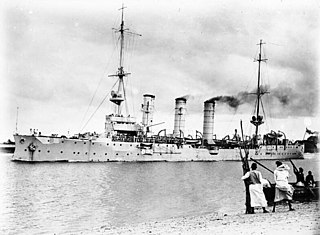
SMS Königsberg was the lead ship of her class of light cruisers built by the German Kaiserliche Marine. Named after Königsberg, the capital of East Prussia, she was laid down in January 1905, launched in December of that year and completed by June 1906. Her class included three other ships: Stettin, Stuttgart, and Nürnberg. Königsberg was armed with a main battery of ten 10.5-centimeter (4.1 in) guns and had a top speed of 24.1 knots.
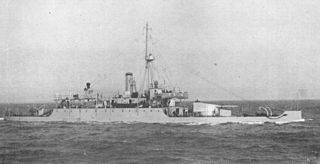
HMS Mersey was a Humber-class monitor of the Royal Navy. Originally built by Vickers for the Brazilian Navy and christened Madeira, she was purchased by the Royal Navy in 1914 on the outbreak of the First World War along with her sister ships Humber and Severn.

The Erebus class of warships was a class of 20th century Royal Navy monitors armed with a main battery of two 15-inch /42 Mk 1 guns in a single turret. It consisted of two vessels, Erebus and Terror, named after the two ships lost in the Franklin Expedition. Both were launched in 1916 and saw active service in World War I off the Belgian coast. After being placed in reserve between the wars, they served in World War II, with Terror being lost in 1941 and Erebus surviving to be scrapped in 1946.

The Battle of the Rufiji Delta was fought in German East Africa from October 1914–July 1915 during the First World War, between the German Navy's light cruiser SMS Königsberg, and a powerful group of British warships. The battle was a series of attempts, ultimately successful, to sink the blockaded German light cruiser.

The Marshal Ney class was a class of monitor built for the Royal Navy during the First World War.

HMS Centaur was a C-class light cruiser of the Royal Navy that served in the First World War and the Russian Civil War. She was the name ship of the Centaur group of the C-class of cruisers.

HMS Weymouth was a Town-class light cruiser built for the Royal Navy during the 1910s. She was the name ship of the Weymouth sub-class of the Town class. The ship survived the First World War and was sold for scrap in 1928.
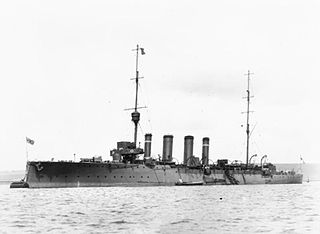
HMS Dartmouth was a Town-class light cruiser built for the Royal Navy in the 1910s. She was one of the Weymouth sub-class of the Town class. The ship survived the First World War and was sold for scrap on 13 December 1930.

HMS Marshal Soult was a Royal Navy Marshal Ney-class monitor constructed in the opening years of the First World War. Laid down as M14, she was named after the French general of the Napoleonic Wars Marshal Jean-de-Dieu Soult. She served in both World Wars and was decommissioned in 1946.
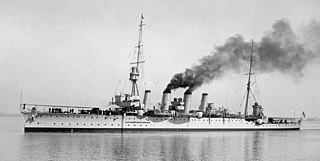
HMS Chatham was a Town-class light cruiser built for the Royal Navy in the 1910s. She was the name ship of her sub-class of the Town class. The ship survived the First World War and was sold for scrap in 1926.

HMS Severn was a Humber-class monitor of the Royal Navy. Originally built by Vickers for Brazil, she was purchased by the Royal Navy in 1914 on the outbreak of the First World War along with her sister ships Humber and Mersey. She had been christened Solimoes by the Brazilians, but was renamed by the British. The three ships were the first of a new type of specialized shore-bombardment warships. As a result of her shallow draught, she was very un-manoeuvrable and unseaworthy in open waters in anything more than a Force 5 wind.

The Königsberg class was a group of four light cruisers built for the German Imperial Navy. The class comprised four vessels: SMS Königsberg, the lead ship, SMS Nürnberg, SMS Stuttgart, and SMS Stettin. The ships were an improvement on the preceding Bremen class, being slightly larger and faster, and mounting the same armament of ten 10.5 cm SK L/40 guns and two 45 cm (17.7 in) torpedo tubes.

HMS Sentinel was one of two Sentinel-class scout cruisers built for the Royal Navy in the first decade of the 20th century. The ship was initially assigned to the Mediterranean Fleet before returning home and being reduced to reserve in 1907. Recommissioned two years later as part of the Home Fleet, she spent the next five years moving on and off of active service in British waters. Sentinel was assigned to coastal defence duties when the First World War began in 1914, although she was transferred to the Mediterranean in 1915. By 1918 the ship had been assigned to the Aegean. After the end of the war in November, Sentinel was sent to the Black Sea as the British attempted to intervene in the Russian Civil War. The ship returned home in early 1919 and was paid off. She became a training ship from mid-1920 to the end of 1922 and was sold for scrap in early 1923.
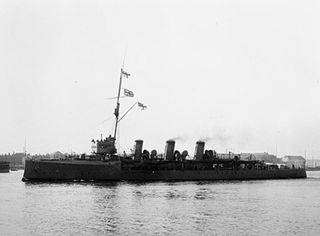
HMS Skirmisher was one of two Sentinel-class scout cruisers built for the Royal Navy during the first decade of the 20th century. Completed in 1905 the ship was placed in reserve until she was commissioned in 1907 as part of the Home Fleet. She then spent the next seven years moving on and off of active service in British waters. Skirmisher was assigned to coastal defence duties when the First World War began in 1914, although she was transferred to the Mediterranean in 1915 and then to the Aegean two years later. The ship returned home in mid-1919 and was sold for scrap in 1920.

HMS Humber was a Humber-class monitor of the Royal Navy. Originally built by Vickers for Brazil as Javary, she was purchased by the Royal Navy in 1914 on the outbreak of the First World War along with her sister ships Severn and Mersey.

The M15 class comprised fourteen monitors of the Royal Navy, all built and launched during 1915.
Admiral Sir Eric John Arthur Fullerton was a Royal Navy officer.

HMS Pyramus was a Pelorus-class protected cruiser of the Royal Navy. There were eleven "Third class" protected cruisers in the class, which was designed by Sir William White. While well armed for their size, they were primarily workhorses for the overseas fleet on "police" duties and did not serve with the main battlefleet.

During the First World War, the Commander-in-Chief at the Cape, Rear Admiral Herbert King-Hall, expended much effort to destroy the elusive German light cruiser Königsberg.


















